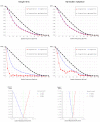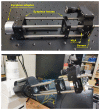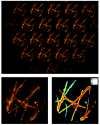The Lightfield Microscope Eyepiece
- PMID: 34640939
- PMCID: PMC8512604
- DOI: 10.3390/s21196619
The Lightfield Microscope Eyepiece
Abstract
Lightfield microscopy has raised growing interest in the last few years. Its ability to get three-dimensional information about the sample in a single shot makes it suitable for many applications in which time resolution is fundamental. In this paper we present a novel device, which is capable of converting any conventional microscope into a lightfield microscope. Based on the Fourier integral microscope concept, we designed the lightfield microscope eyepiece. This is coupled to the eyepiece port, to let the user exploit all the host microscope's components (objective turret, illumination systems, translation stage, etc.) and get a 3D reconstruction of the sample. After the optical design, a proof-of-concept device was built with off-the-shelf optomechanical components. Here, its optical performances are demonstrated, which show good matching with the theoretical ones. Then, the pictures of different samples taken with the lightfield eyepiece are shown, along with the corresponding reconstructions. We demonstrated the functioning of the lightfield eyepiece and lay the foundation for the development of a commercial device that works with any microscope.
Keywords: 3D microscopy; FiMic; Fourier integral microscope; lightfield eyepiece; lightfield microscopy; plenoptic eyepiece.
Conflict of interest statement
The authors declare no conflict of interest. The funders had no role in the design of the study; in the collection, analyses, or interpretation of data; in the writing of the manuscript, or in the decision to publish the results.
Figures









References
-
- Sheppard C., Cogswell C. Three-dimensional image formation in confocal microscopy. J. Microsc. 1990;159:179–194. doi: 10.1111/j.1365-2818.1990.tb04774.x. - DOI
-
- Kino G.S., Corle T.R. Confocal Scanning Optical Microscopy and Related Imaging Systems. Academic Press; Cambridge, MA, USA: 1996.
-
- Schermelleh L., Carlton P.M., Haase S., Shao L., Winoto L., Kner P., Burke B., Cardoso M.C., Agard D.A., Gustafsson M.G., et al. Subdiffraction multicolor imaging of the nuclear periphery with 3D structured illumination microscopy. Science. 2008;320:1332–1336. doi: 10.1126/science.1156947. - DOI - PMC - PubMed
MeSH terms
Grants and funding
LinkOut - more resources
Full Text Sources

